Quantum<>Magnum
What if random samples of life forms, from the largest to the smallest, were compared? This series is a re-combination of fragments of science and art,
begging us to see that reality stimulates imagination, and art simulates reality.
photographs, silk fiber, wire
20” x 20” x 1/2”
BANG address birthing the universe. It begs the question, “Why is there something rather than nothing?” In 1979, Dr. Alan Guth suggests that at the very beginning, a special force moving faster than the speed of light pushed out our rapidly expanding universe equally, his theory of “Inflation” and gravitational waves, so that rather than having a jagged, uneven expansion, we are in fact moving out in equal proportions. If we could draw a shape around the edges, it most likely would form a sphere or circle. The universe is said to be 13.8 billion years old. It is composed of 4.9% atomic matter, 26.6% dark matter, and 68.5% dark energy - the forces that continues to grow our universe.
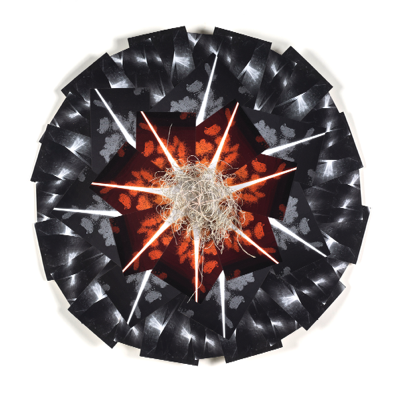
GALAXY is the result of irregularities in microwave radiation, left over from the Big Bang. Einstein called these primordial, antigravity
occurrences “cosmological constants”. They are still being studied.
Dark matter appears to provide the bones for galaxies, with hydrogen, helium, and small traces of lithium, initially, the main ingredients, which fused to form metals (iron). Our universe is estimated to contain 100 to 200 billion galaxies. And although each resembles a spiral, the concomitant shape reflects something circular.
.

paper, wire, scrap and granular iron, magnets, colored pencil ,acrylics
20" x 20" x 1/2"
paper, nylon screen, ink, silk fiber
20” x 20” x 1/2”
EARTH a result of thermonuclear reactions that supplied iron, carbon, and oxygen, necessary for planets to form. Early earth atmosphere contained carbon dioxide, methane, and hydrogen. By 3 billion years ago, some microbes containing chlorophyll, evolved an ability to use photosynthesis. Floating on the ocean, enhanced by sunlight, they gave off their waste oxygen, enabling planetary growth and the emergence of Pangea (Pan - whole, Gaia - mother earth) 300 million years ago. Thus began the marinating of geology and biology. First continents, clockwise: Eurasia, Africa, India, Antartica, Australia, South America, North America.
paper, linen and silk fibers
20” x 20” x 12”
FIELD exhibits a flourishing of biology, enhanced by the growth of insect and bird life which spread species. Geology and biology mingle for a continuously changing environment, influenced by the health of soil microbes and airborne life, access to water and sunlight. Growing on those fields are flowers resplendent in circular form.
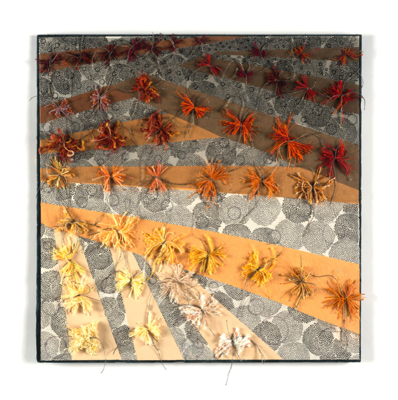
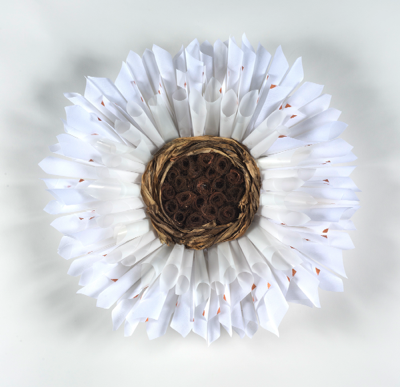
vellum, paper, corn husks, copper wire, copper acrylic
20” x 20” x 1/2”
FLOWER (Helianthus anus) illustrates our visual culmination of events so far. We can rest here a bit with the familiar. The seeds were used by aboriginal indians as food and for oil, the petals for yellow dye, the stalks for weaving fine silk-like garments. In 1926, the Missouri Sunflower Growers’ Association participated in the first commercial sunflower seed oil production. 13 bird species from Cardinals to Woodpeckers enjoy this seed, which has both male and female components.
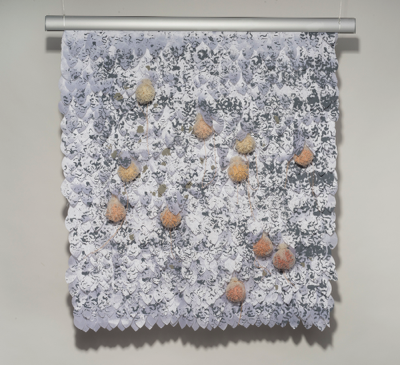
polyester, gum tree seeds, netting, ink print
20” x 20” x 1/2”
POLLEN directs the future of plant life. Born by insect, bird, and wind, it is self creating. Sunflower pollen is fluorescent and used to calibrate microscopes. It is waxy and has long sharp spines, resembling Sweet Gum tree fruit, which protect its genetic matter and resists destructive fossilization processes. Therefore, we have abundant records for this type of fossilized pollen. The smallest pollen grain is found in Forget Me Nots.
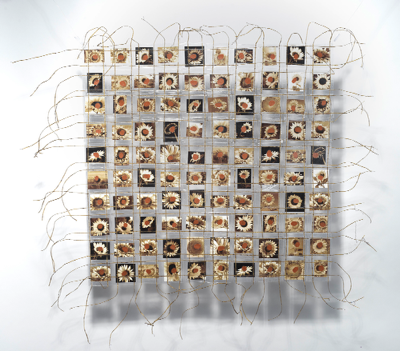
prints, clear pellon, silk fibers
20” x 20” x 1/2”
CELL defines the structure of all life forms. From the Latin word “cella”, meaning small room, cells were identified by Robert Hooke in 1665 after examining them in cork. For him, these cells were reminiscent of
rooms in which monks lived in monasteries. They contain all information necessary to reproduce. A permeable protective membrane allows molecules to enter and leave. Proteins are essential for all activities. Emerging 3.5 billion years ago, cells evolved into 3 dimensional structures, with different tasks: moving, eating, digesting, communicating.
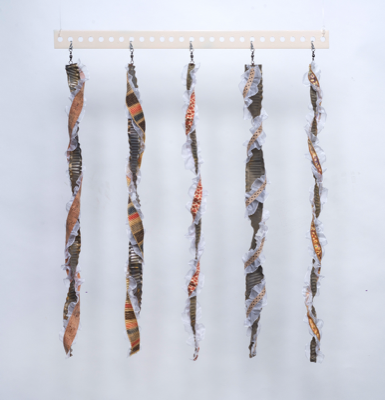
metal strips, cotton fibers, polyester ribbon
20” x 20” x 1/2”
DNA is a nucleic acid within each cell that, along with proteins and carbohydrates, identifies all living organisms. This double helix, discovered by James Watson and Francis Crick in 1953, contains all necessary biological information. It’s chromosomes, with histone proteins, are circular and replicate when cells divide. A gene is a sequence of DNA. Since DNA cannot live beyond 1 million years, it is difficult to trace its origin and evolution.

paste papers, knotted fibers, copper wire
20" x 20" x 1/2"
QUARK is the smallest particle we know of so far. It combines to form protons and neutrons (hadrons) which comprise atomic nuclei. It was first introduced in 1964 by Murray Gell-Mann and George Zweig. A Quark’s properties are fractional electric charges, mass, color charges, and spin. It is the only elementary particle able to perform all fundamental forces: electromagnetism, gravitation, strong interaction and weak interaction There are 6 flavors: up/down, strange/charm, and top/bottom. The Top Quark the most recent discovery which occurred at Fermilab in 1995. The word is found in Finnegan’s Wake by James Joyce:
“Three quarks for Muster Mark!
Sure he has not got much of a bark
And sure any he has it’s all beside the mark.”

All pieces produced in 2015